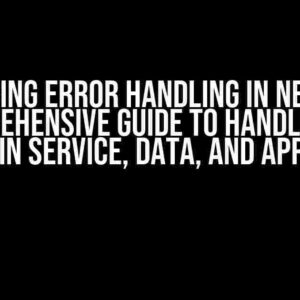Are you trying to tap into the world of Formula 1 racing data using the FastF1 API in your Flask application, but running into errors and roadblocks? Fear not, friend! This article is here to help you navigate the pit stops and straightaways of making successful API calls and getting the data you need to fuel your project.
Understanding the Basics of FastF1 API
Before we dive into the nitty-gritty of making API calls, let’s take a quick look at what the FastF1 API is and what it offers.
The FastF1 API is a RESTful API that provides access to a vast array of Formula 1 racing data, including:
- Live timing data
- Session results
- Driver and team information
- Race schedules and calendars
- And more!
The API uses HTTP requests to fetch data, and responses are returned in JSON format, making it easy to integrate with your Flask application.
Setting Up Your Flask App for FastF1 API Calls
To make API calls to FastF1, you’ll need to have Flask installed and set up in your project. If you haven’t already, create a new Flask app using the following command:
flask new my_f1_appNext, create a new file called `app.py` and add the following code to set up your Flask app:
from flask import Flask
app = Flask(__name__)
@app.route("/")
def hello_world():
return "Hello, World!"
if __name__ == "__main__":
app.run(debug=True)This sets up a basic Flask app with a single route that returns “Hello, World!” when visited in a web browser.
Installing the FastF1 Library
To interact with the FastF1 API, you’ll need to install the official FastF1 library using pip:
pip install fastf1This library provides a convenient way to make API calls and parse the responses.
Making Your First FastF1 API Call
Now that you have the FastF1 library installed, let’s make your first API call! Create a new file called `fastf1_calls.py` and add the following code:
import fastf1
fastf1.Cache.enable_cache() # Enable caching for faster responses
def get_current_season():
response = fastf1.api.current_season()
return responseThis code sets up the FastF1 cache to reduce the number of API calls and speed up response times. The `get_current_season()` function makes a GET request to the API to retrieve the current Formula 1 season.
Handling API Responses
When the API call is successful, the response is returned as a JSON object. You can access the data using the dot notation, like this:
season_data = get_current_season()
print(season_data.Season.Name)This code prints the name of the current season to the console. You can explore the response object further to access other data, such as the season’s start and end dates, or the list of races.
Troubleshooting Common Errors
As you start making API calls, you may encounter errors or issues. Here are some common problems and their solutions:
| Error | Solution |
|---|---|
fastf1.errors.APIError: API rate limit exceeded |
Check your API key and usage limits. You may need to upgrade your subscription or wait until the rate limit resets. |
OAuthError: Unauthorized |
Verify your API key and authentication credentials. Make sure they are correct and up-to-date. |
JSONDecodeError: Expecting value: line 1 column 1 (char 0) |
Check the API response for errors. It’s possible the API returned an error message instead of the expected JSON data. |
Best Practices for Making FastF1 API Calls
To ensure smooth sailing and avoid common pitfalls, follow these best practices when making API calls:
- Use caching: Enable caching to reduce the number of API calls and speed up response times.
- Handle errors: Use try-except blocks to catch and handle API errors and exceptions.
- Check the API documentation: Familiarize yourself with the FastF1 API documentation to understand what data is available and how to access it.
- Use the correct API endpoint: Make sure you’re using the correct API endpoint for the data you need.
- Test and iterate: Test your API calls and iterate on your code to ensure it’s working as expected.
Conclusion
By following this guide, you should now be able to make successful FastF1 API calls in your Flask application. Remember to handle errors, use caching, and follow best practices to ensure a seamless experience. With the vast array of data available through the FastF1 API, the possibilities are endless! So, what are you waiting for? Get started and fuel your F1 passion project today!
Frequently Asked Questions
Stuck on making a FastF1 API call in your Flask app? Don’t worry, we’ve got you covered! Here are some common questions and answers to help you troubleshoot the issue:
What is the correct API endpoint for making a FastF1 API call?
The correct API endpoint for making a FastF1 API call is `https://api.fastf1.io/api`. Make sure to check the official FastF1 API documentation for the most up-to-date information on available endpoints and parameters.
Do I need to authenticate my FastF1 API requests in my Flask app?
Yes, you need to authenticate your FastF1 API requests by providing a valid API key or token. You can obtain an API key by creating an account on the FastF1 website and following their instructions for API key generation.
What is the correct format for passing parameters in my FastF1 API request?
The correct format for passing parameters in your FastF1 API request depends on the specific endpoint and method you’re using. For example, when making a GET request, you can pass parameters as query string arguments, such as `https://api.fastf1.io/api/races?season=2022&round=1`. For POST requests, you can pass parameters in the request body as JSON.
How do I handle rate limiting and errors when making FastF1 API calls?
FastF1 has rate limits on API requests to prevent abuse. You can handle rate limiting by implementing a caching mechanism, such as using Redis or Memcached, to store API responses for a certain period of time. For errors, you can use try-except blocks to catch and handle API errors, and implement retry mechanisms to handle temporary errors.
What is the best way to integrate the FastF1 API with my Flask app?
The best way to integrate the FastF1 API with your Flask app is to create a separate module or class that handles API requests and interactions. This will allow you to keep your API logic separate from your app logic and make it easier to maintain and update your code. You can use libraries like `requests` and `json` to make API requests and parse responses.
I hope these questions and answers help you troubleshoot any issues you’re having with making a FastF1 API call in your Flask app!


